Food Micro - credit qs
In STAR protocol, the test bacterium Bacillus cereus is used for the detection of
Select one:
macrolides
beta-lactams
tetracyclines
aminoglycosides
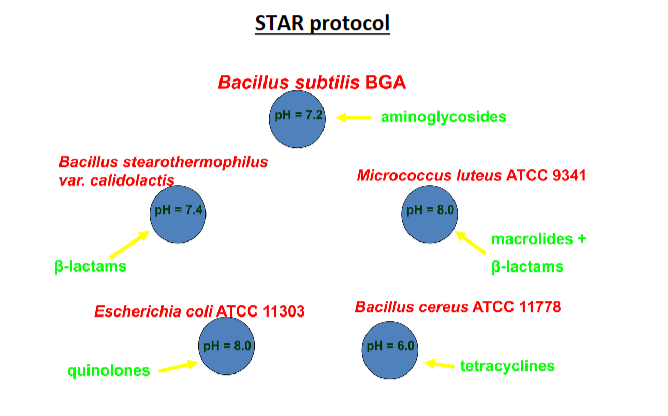
Tetracyclines
The following culture medium is used for enumeration of yeasts and mould in food products with water activity equal or less than 0.95
a. DRBC
b. TBX
c. DRBG
d. DG-18
DG-18
1/63
Earn XP
Description and Tags
2023, 2021 (Foodmicro biology-credittest), 2020(Food Micro credit test old Qs)
Name | Mastery | Learn | Test | Matching | Spaced |
|---|
No study sessions yet.
64 Terms
In STAR protocol, the test bacterium Bacillus cereus is used for the detection of
Select one:
macrolides
beta-lactams
tetracyclines
aminoglycosides
Tetracyclines

The following culture medium is used for enumeration of yeasts and mould in food products with water activity equal or less than 0.95
a. DRBC
b. TBX
c. DRBG
d. DG-18
DG-18
To detect the presence/absence of Salmonella, the initial suspension is prepared by mixing?
a. 25 grams of the test portion with 225 ml of peptone salt solution
b. 10 grams of the test portion with 90 ml of buffered peptone water
c. 10 grams of the test portion with 90 ml of peptone salt solution
d. 25 grams of the test portion with 225 ml of buffered peptone water
25 grams of the test portion with 225 ml of buffered peptone water
In terms of food safety, staphylococcus aureus is a?
a. Potentially (conditionally) pathogenic bacterium
b. Pathogenic bacterium
c. Commensal bacterium
d. Toxigenic bacterium
Toxicogenic bacterium
Enumeration of Enterobacteriaceae Count in Food Sample:
Dilution 10⁻¹: 148 to 156 colonies
Dilution 10⁻²: 10 to 15 colonies
Dilution 10⁻³: 1 to 2 colonies
The count of Enterobacteriaceae in 1 gram of the test sample was:
Options:
□ N = 1.4 × 10³ CFU·g⁻¹
□ N = 1.4 × 10⁴ CFU·g⁻¹
□ N = 1.5 × 10³ CFU·g⁻¹
□ N = 1.5 × 10⁴ CFU·g⁻¹
correct: N = 1.4 × 10³ CFU·g⁻¹
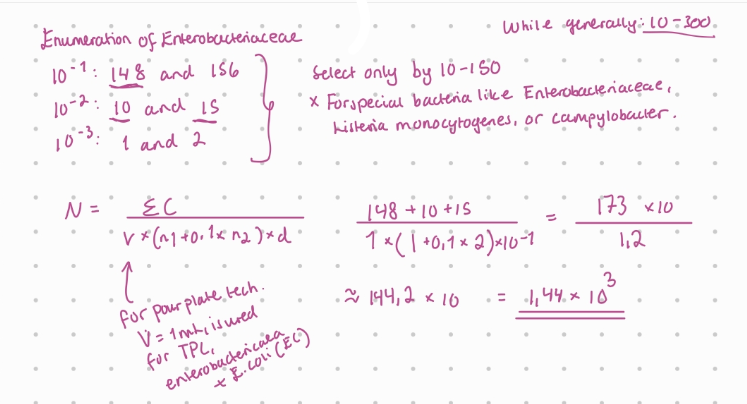
in food microbiology, the following diluent(s) is(are) used for decimal dilutions"
Options:
sterile distilled water
sterile peptone water
sterile peptone salt solution
sterile buffered peptone water
sterile demineralized water
sterile deionized water
all of these are used as diluents in food micro. Most common are peptone water and buffered peptone water.
"In STAR protocol, the test bacterium Kocuria varians (Micrococcus luteus) is used for the detection of"
Selected options:
macrolides
aminoglycosides
sulphonamides
quinolones
tetracyclines
beta-lactams
beta-lactams, macrolides
Culture media for microbiological testing are sterilized in the
Options:
sterilizing oven with forced-air convection
steamer
incubator without forced-air convection
autoclave
incubator with forced-air convection
sterilizing oven without forced-air convection
Autoclave, steamer
The following storage temperatures are recommended for samples of technological swabs awaiting microbiological testing
18-27 °C
2-8 °C
1-4 °C
0-2 °C
1-4 °C
The following culture medium must be used for testing antimicrobial resistance by the disk diffusion method
Rappaport-Vassiliadis agar
Müller-Hinton agar
Müller-Kauffmann agar
Kirby-Bauer agar
Müller-Hinton agar
In food microbiology, the pour plate technique is not used for enumeration of
Select one:
- Total plate count
- β-glucuronidase-positive Escherichia coli
- yeasts and moulds
- Enterobacteriaceae
yeasts and moulds
The following temperatures are recommended for the transport of products not stable at ambient temperature to the laboratory
Select one:
below-15 °C,
preferably below-18 °C
1–8 °C
18–27 °C
0–5 °C
2 ± 2 °C
1–8 °C
The most common type of homogenizer in microbiological laboratory is that
Select one or more:
vibrationa
peristaltic
rotary
vortex mixer
peristaltic
Culture medium TBX is used for enumeration of
Select one:
coagulase-positive staphylococci
Salmonella sp.
Enterobacteriaceae
β-glucuronidase-positive E. coli
β-glucuronidase-positive E. coli
On the surface of ALOA agar, bacteria Listeria monocytogenes grow in
Select one:
- greyish green or olive green colonies, sometimes with black centres, but always with black halos
- pink, red, or purple colonies with or without precipitation haloes
- black or grey colonies surrounded by a clear zone which may be partially opaque, sometimes an
- 11 palescent ring immediately in contact with the colonies may appear in this clear zone
- green-blue colonies surrounded by an opaque halo
- green-blue colonies surrounded by an opaque halo
The name of culture medium enabling stressed and damaged micro-organisms tore pair and recover their capacity for normal growth without necessarily promoting their multiplication is
Select one:
- preservation medium
- suspension medium
- resuscitation medium
- transport medium
resuscitation medium
To determine the total count of psychrotrophic micro-organisms, inoculated plates are incubated
Select one:
at 5 °C for 10 days
at 20 °C for 5 days
at 30 °C for 3 days
at 10 °C for 7 days
at 5 °C for 10 days
All genera in the Enterobacteriaceae family are
Select one:
Gram-positive, glucose-positive and oxidase-negative
Gram-negative, glucose-positive and oxidase-positive
Gram-positive,glucose-positive and oxidase-positive
Gram-negative, glucose-positive and oxidase-negative
Gram-negative, glucose-positive and oxidase-negative
Negative result of PREMI®test (no residues of inhibitory substances are present in the test sample) is manifested by
Select one:
yellow colouration of the tube content
green colouration of the tube content
violet colouration of the tube content
black colouration of the tube content
yellow colouration of the tube content
When eating Enterobacteriaceae using the colony count method, the initial suspension is prepared by mixing
Select one:
10 grams of the test portion with 90 mL of buffered peptone water
10 grams of the test portion with 90 mL of EE broth
10 grams of the test portion with 90 mL of peptone salt solution
25 grams of the test portion with 225 mL of peptone salt solution
25 grams of the test portion with 225 mL of peptone salt solution
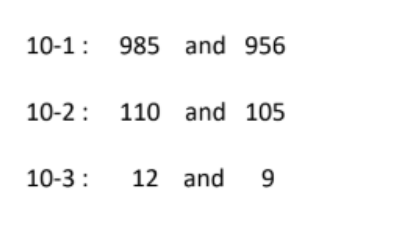
Enumeration of enterococci provided the following counts of colonies
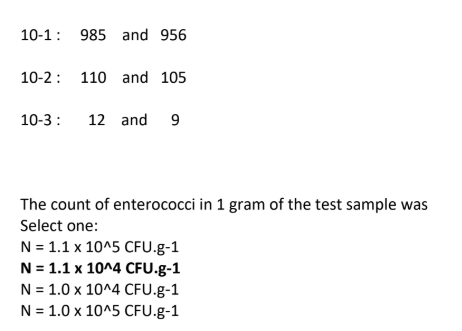
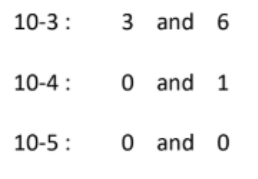
Enumeration ofβ-glucuronidase-positive E. coli provided the following counts of colonies:
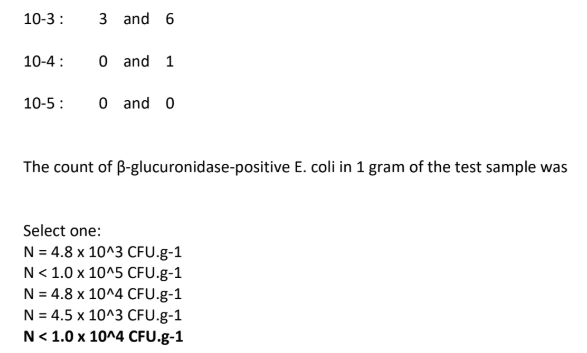
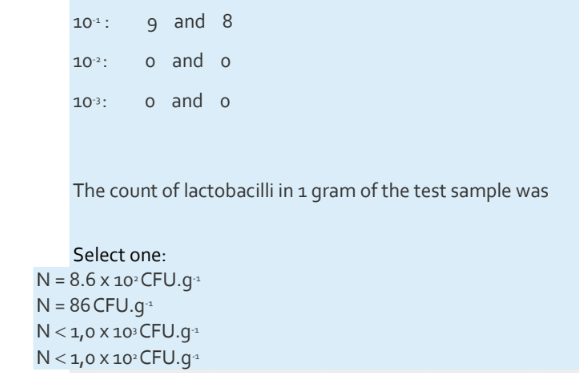
Enumeration of lactobacilli provided the following counts of colonies
correct: 1.0 × 10³
NE < 10 / 0.1 × 10`-1
In food microbiology, Baird-Parker agar is used for enumeration of
Select one:
yeasts and moulds
Enterobacteriaceae
beta glucuronidase-positive E. coli
coagulase-positive staphylococci
coagulase-positive staphylococci
The following culture medium is used for enumeration of yeasts and mould in food products with water activity greater than 0.95
Select one:
TBX
DRBC
DRBG
DG-18
DRBC
The following diluent is used to prepare the initial suspension and further decimal dilutions during quantitative microbiological examination of food samples by colony count method
Select one:
sterile nutrient broth
sterile buffered peptone water
sterile distilled water
sterile peptone salt solution
sterile peptone water
sterile demineralized water
sterile peptone salt solution
Ready-to-eat foods that do not support the growth ofListeria monocytogenesare those with
Select one:
aw<0.95, regardless of pH
pH< 4.4,regardless of water activity (aw)
a combination of pH< 5.0 and water activity (aw)< 0.96
'pH< 5.0,regardless of water activity (aw
pH< 4.4,regardless of water activity (aw)
Typical colonies of Salmonella sp. on the surface of XLD agar
Select one:
are pink, red, or purple with or without precipitation haloes
have black centers sorrounded by lightly transparent reddish zones
are green-blue, surrounded by an opaque halo
are black orgrey, surrounded by a clear zone which may be partially opaque, sometimes an oppalescent ringimmediately in contact with the colonies may appear in this clear zone
have black centers sorrounded by lightly transparent reddish zones
Egg yolk emulsion added to Baird-Parker agar medium indicates
Select one:
coagulase activity
lipolytic activity
glycolytic activity
proteolytic activity
lipolytic activity
The following quantity of the test sample is used for preparation of the initial suspension during qualitative microbiological examination
Select one:
10 grams
20 grams
1 gram
25 grams
10 grams
To determine the total aerobic count of mesophilic micro-organisms, the inoculated PCA plates are incubated
Select one:
at 30 °C for 3 days
at 20 °C for 5 days
at 37 °C for 2 days
at 44 °C for 1 day
at 30 °C for 3 days
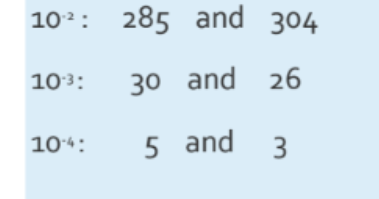
Determination of Total Plate Count provided the following counts of colonies:
2,8 × 104
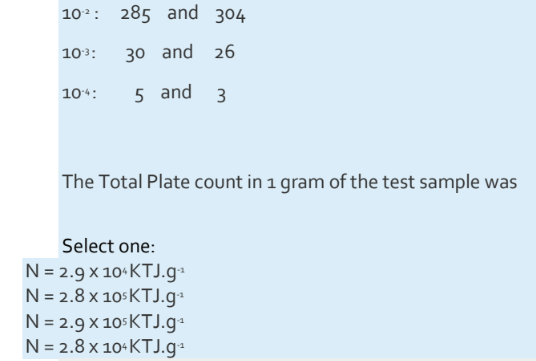
The name of culture medium designed to preserve and maintain the viability of micro-organisms whilst minimising numerical change in the time period between sampling and laboratory processing of the samples is
Select one:
suspension medium
resuscitation medium
transport medium
preservation medium
transport medium
In microbiological laboratory, the following method is preferably used for sterilization of culture media
Select one:
autoclaving at 121 °C and pressure 0.15 MPa for at least 30 minutes
dry heat in a sterilizing oven at 150 °C for at least 2 hours
dry heat in a sterilizing oven at 170 °C for at least 1 hour
autoclaving at 121 °C and pressure 0.15 MPa for at least 15 minutes
autoclaving at 121 °C and pressure 0.15 MPa for at least 15 minutes
The following bacteria can be found in both the fresh water and seawater
Select one:
Yersinia sp.
Aeromonas sp
Pseudomonas sp.
Vibrio sp
Vibrio sp
The enumeration of Enterobacteriaceae using the most probable number (MPN) is applicable when the expected number of Enterobacteriaceae is
Select one or more:
below 100 CFU/mL of the test sample
below 10 CFU/g of the test sample
below 10 CFU/mL of the test sample
below 100CFU/g of the test sample
below 10 CFU/mL of the test sample
below 100CFU/g of the test sample
-
If they ask for 2 coorect this
if ask for 1 correct: below 10 CFU/mL of the test sample

The genus Clostridium includes
Select one:
lipolytic bacteria
saccharolytic bacteria
proteolytic bacteria
proteolytic and lipolytic bacteria
proteolytic and saccharolytic bacteria
proteolytic and saccharolytic bacteria
The culture medium TBX contains the following selective agent
Select one:
- X-glucuronide
- Bile salts
- Tryptone
- Crystal viole
(not - X-glucuronide)
Bile salts - selective agent

The devitalization of micro-organisms by high temperatures results from
Select one or more:
- inactivation of enzymes
- melting of lipids in the cytoplasmic membrane
- ionizing of water molecules
- acid-base disbalance within the cell
inactivation of enzymes
melting of lipids in the cytoplasmic membrane
The following micro-organisms belong to obligate aerobes
Select one or more:
Escherichia coli
Pseudomonas sp.
Clostridiumsp.
Penicillium sp.
Pseudomonas sp.
Penicillium sp.
The following tests are used to confirm Listeria spp. (The genus Listeria).
Select one or more:
- heamolysis test
- utilization of rhamnose
- CAMP test
- Gram-staining
- Henry illumination test
- catalase reaction
motility test
utilization of xylose
Gram-staining
Henry illumination test
catalase reaction
also motility test
The following tests are used to confirm Campylobacter spp.
select one or more:
catalase reaction
aerobic growth at 25 °C
aerobic growth at 41.5 °C
motility test
oxidase reaction
formation of hydrogen sulphide
aerobic growth at 25 °C
Motility test - checking for corkscrew motility
oxidase activity - positive
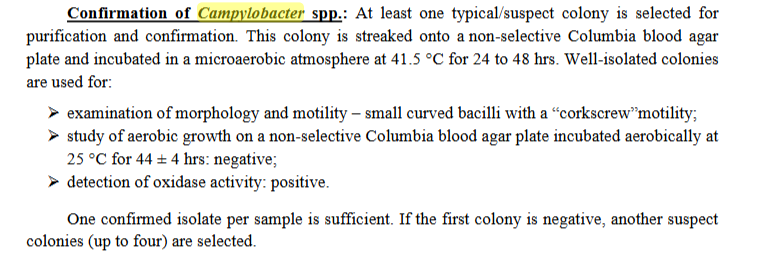
in the microbiological laboratory, sterilization of heat-labile culture media is preferably done by
Select one:
- dry heat in a sterilizing oven
- moist heat in an autoclave
- dry heat in a microwave oven
- moist heat in a steamer
moist heat in a steamer
The subspecies of Salmonella enterica do not include
Select one:
ssp.bongori
ssp.enterica
ssp.salamae
ssp.arizonae
ssp.indica
ssp.bongori
The resolution of the balance used for weighing the test portion, components of the culture media and reagents should achieve a tolerance of
Select one or more:
0.1 %
0.1 gram
0.01 %
1 gram
0.01 gram
1 %
1%
In microbiological laboratory, freezers shall be available to achieve separation for the storage of
Select one or more:
- uninoculated culture media
- microbial cultures
- inoculated culture media
- food samples for analysis
microbial cultures
food samples for analysis
Micro-organisms converting monosaccharides to organic acids and gases in the process of fermentation are known as
Select one:
saccharolytic
lipolytic
glycolytic
proteolytic
glycolytic
The preservation effect of salting is based on the following
Select one or more:
- decrase in water activity(aw)
- increase in osmotic pressure
- increase in pH-value
- decrease in redox potential
decrase in water activity(aw)
increase in osmotic pressure
The culture medium Plate Count Agar (PCA)
Select one or more:
- is used for determination of the Total plate count
- is a solid, chromogenic and differential medium
- is a solid, synthetic medium which contains one indicator and two selective agents
- is a solid, synthetic medium which contains growth factors
- is used for determination of the Total plate count
- is a solid, synthetic medium which contains growth factors
The name of selective agents present in VRBA are
Select one or more:
bile salts
crystal violet
potassium tellurite
lithium chloride
bile salts
crystal violet
The following culture bacteria are used for yoghurt preparation
Select one or more:
Leuconostoc mesenteroidesssp.dextranicum
Streptococcus termophilus
Streptococcus lactisssp. cremoris
Lactobacillus delbrueckiissp. bulgaricus
Streptococcus termophilus
Lactobacillus delbrueckiissp. bulgaricus
Typical strains of enterohaemorrhagic E. coli O157 are
Select one:
glucose-negative, sorbitol-negative, glucuronidase-negative and oxidasepositive
glucose-negative, sorbitol-positive, glucuronidase-positive and oxidase positive
glucose-positive, sorbitol-negative, glucuronidase-positive and oxidase negative
glucose-positive, sorbitol-negative, glucuronidase-negative and oxidase negative
glucose-positive, sorbitol-negative, glucuronidase-negative and oxidase negative
The group of lactic acid bacteria (LAB) includes
Select one or more:
Staphylococcus sp.
Lactobacillus sp.
Leuconostoc sp.
Enterobacter sp.
Streptococcus sp.
Micrococcus sp
Lactobacillus sp.
Leuconostoc sp.
Streptococcus sp.
Multiplication of micro-organisms is retarded, generation time is prolonged and a slow decrease in viable cell numbers is observed in the following growth phase
Select one:
Stationary phase
Logarithmic decline phase
Phase of negative acceleration
Lag phase
Phase of positive acceleration
Logarithmic phase
Phase of negative acceleration
In the PCR method, the cycles of DNA amplification include the following three basic steps
Select one:
extraction, purification and extension
denaturation, annaeling and extension
neutralization, annaeling and extraction
denaturation, extraction and purification
denaturation, annaeling and extension
The following nitrogen-fixing bacteria are found in the soil
Select one:
Nitrobacter spp.
Nitrosomonas spp.
Rhizobium spp.
Achromobacter spp
Rhizobium spp.
In food microbiology, the pour plate technique is used for enumeration of
Select one or more:
- coagulase-positive staphylococci
- β-glucuronidase-positive Escherichia coli
- Total plate count
- Enterobacteriaceae
- enterohaemorrhagic Escherichia coli O157
- yeasts and moulds
β-glucuronidase-positive Escherichia coli
Total plate count
Enterobacteriaceae
When enumerating coagulase-positive staphylococci by the colony count method, the initial suspension is prepared by mixing
Select one:
10 grams of the test portion with 90 mL of buffered peptone water
25 gram of the test portion with 225 mL of peptone salt solution
1 gram of the test portion with 9 mL of buffered peptone water
10 grams of the test portion with 90 mL of peptone salt solution
10 grams of the test portion with 90 mL of peptone salt solution
The following type(s) of biosafety cabinets is (are) used for work with risk category 3 pathogens
Select one:
Class I biosafety cabinets
Classes I and II biosafety cabinets
Class II biosafety cabinets
Classes II and III biosafety cabinets
Class III biosafety cabinet
Class II biosafety cabinets
In the STAR protocol, the test-bacterium Escherichia coli ATCC 11303 is used to detect the residues of
Select one:
- sulphonamides
- aminoglycosides
- β-lactams
- quinolones
- tetracyclines
- macrolides
quinolones
Inoculated DG-18 plates are incubated aerobically
elect one:
at 10 °C for 7-10 days
at 30 °C for 3-5 days
at 25°C for 5-7 days
at 5 °C for 10-12 days
at 25°C for 5-7 days
A condition in which the growth and metabolism of one micro-organism alter the environment to allow the growth of another miro-organism is known as
Select one:
metabiosis
mutualism
commensalism
amensalism
antibiosi
metabiosis
The group of thermotolerant enteropathogenic campylobacters does not include
Select one:
Campylobacter jejuni
Campylobacter mucosalis
Campylobacter lari
Campylobacter upsaliensis
Campylobacter col
Campylobacter mucosalis
Sublethal injury of Salmonella cells is manifested by the following
Select one or more:
decrease in enzymatic activity
inability of bacteria to form visible colonies
changes in the cell antigenic structure
false-positive results of microbiological testing
decrease in enzymatic activity
inability of bacteria to form visible colonies (part. on selective media)